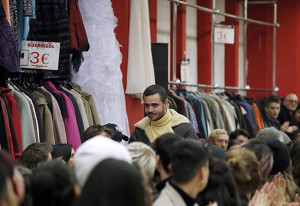
It is a humdrum secondhand clothing store in one of the most down-at-heel districts of the French capital.
But for designer Francisco Terra and other rising stars of the Paris catwalk, the shop stuffed with shirts and skirts that sell for the price of a coffee is “a temple of fashion research.”
Terra loves the place so much he held his Paris fashion week show in the store, the flagship “friperie” of the Guerrisol chain.
“It is not just people who don’t have much money who shop here,” the creator behind the Neith Nyer label said, “but all the stylists of the big labels who come to do their homework.”
His show comes only six weeks after hip brand AVOC presented their menswear collection in another more upmarket vintage store.
With high street chains going hell for leather for throwaway fashion, those in the know are embracing better quality vintage clothing while designers are turning to secondhand and charity shops for inspiration.
Parisian friperies where the poor still buy pre-owned shoes and suits are now the haunt of hipsters and fashionistas looking for clothes that help them stand out.
Putting together “a look is all about the exclusivity of the piece,” said Brazilian-born Terra, who worked for Givenchy and Carven before striking out on his own.
“Today with mass market fast fashion, you can only find that in vintage of secondhand shops,” he added.
‘Upcycled’ jeans
Influenced by Margiela and Jean Paul Gaultier, two fashion houses who have long embraced the art of recycling, 34-year-old Terra began to repurpose clothes for his own brand, which he named after his Austrian grandmother.
His new show is set in a fictional future Tokyo in 2083. Faced with a chaotic economy, young people are forced to patching their ancestors’ old clothes together to create their new styles.
The storyline was inspired by the Japanese capital’s thriving secondhand stores, Terra said, which often rework old clothes.
Upcycling, as remaking existing clothes is called, has long been the trademark of a number of Paris labels, including streetwear brand Andrea Crews.
Upcycled jeans made from cut up old Levi’s were also one of the things that helped make French brand Vetements the label of the moment.
Vintage is also a major theme at a trade fair running alongside Paris fashion week, which this year contains a shop bringing together some of the capital’s “pre-worn” designer stores and the online luxury secondhand site Vestiaire Collective.
Amnaye Nhas, a manager of one such luxury Paris store, Thanx God I’m a VIP, said sales rocket during the runway shows, particularly when labels revisit historic looks for coats and aviator jackets.
Vintage can be reassuring
Her store only sells clothing from the very top designer labels. They refuse to handle anything in synthetic fiber and outfits have to be in perfect condition, she said.
With prices ranging from 40 euros to 2,000 ($42 to $2,100), Nhas said their clients are demanding and know what they want.
A green toned Leonard silk jacket is on sale for 995 euros, while a 1978 Burberry coat is priced at 450 euros.
“Some customers are real sticklers” for designer labels, she said, “but others would normally shop in high street stores like Zara and just want to find something original to wear with that.”
Fashion historian Manuel Charpy said vintage mania is nothing new.
“In the 19th century, secondhand clothing was much more important than today, completely dominating the mass market” and items were sold again and again, he said.
The current hunger for vintage began out of economic necessity after the financial crisis of 2008, said trends specialist Cecile Poignant.
The success of the American television series “Mad Men”, set in the early 1960s also helped, she said.
Vintage clothes “give people reassurance and historical anchorage in changing times,” Poignant added.
“It all has to do with the sense of insecurity people are living with today. We are a lot less sure than we were 30 years ago that the future will be brighter.” JB